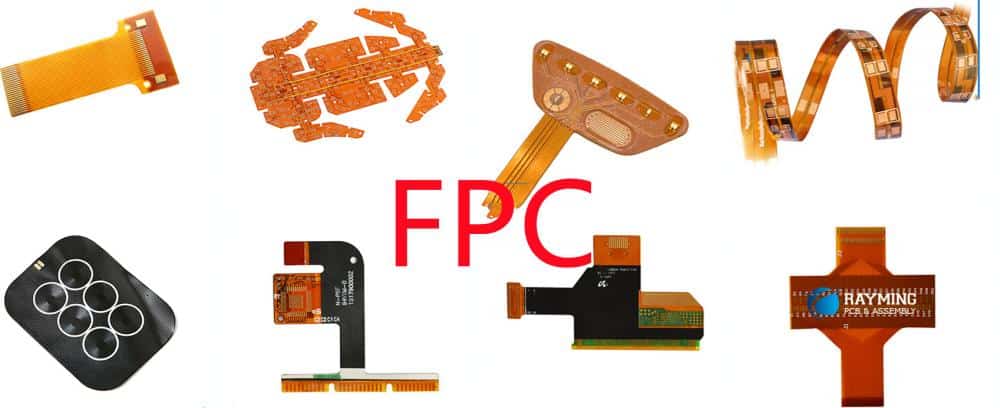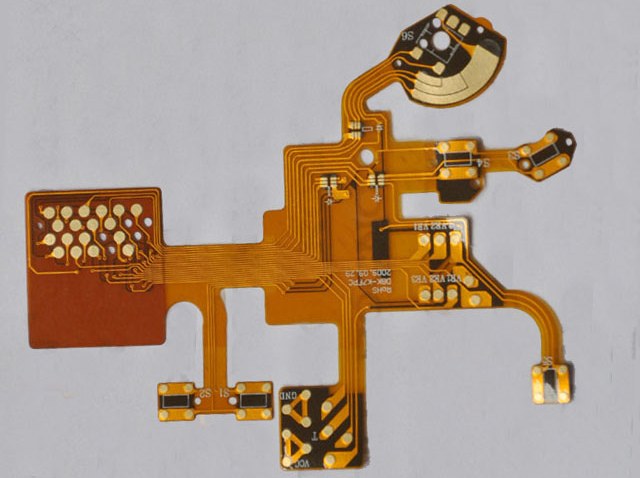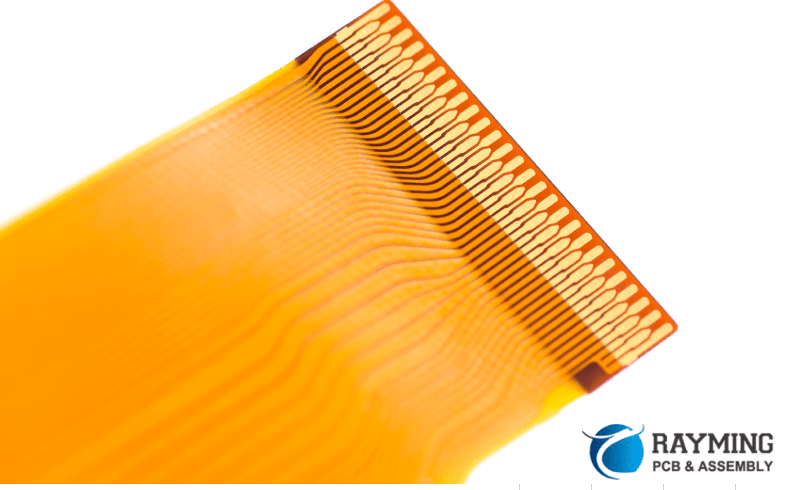Introduction to Flex PCBs
A flex PCB (flexible printed circuit board) is a type of printed circuit board that is made of a flexible, bendable material. The most common base material for flex PCBs is polyimide, which can be bent and flexed repeatedly without damage.
Flex PCBs provide several advantages compared to traditional rigid PCBs:
- They can bend and flex to fit into tight or complex spaces in electronic devices. This allows for more compact product designs.
- They are extremely lightweight and thin.
- They can connect components that move or change position in a device, like in a foldable smartphone. The flex PCB can bend and flex with the components.
- They can be manufactured in very high densities, with trace widths and spaces down to 25 micron. This enables highly compact circuit layouts.
- They are resistant to vibration and impact damage.
Some of the key applications for flex PCBs include:
- Wearable devices
- Medical devices
- Consumer electronics
- Automotive electronics
- Aerospace and military products
Flex PCBs come in many varieties, including single-layer, double-layer, multilayer, rigid-flex, and sculpted flex. They can be manufactured with a wide range of features to suit the specific design needs of the application.
Benefits of Using OSH Park for Flex PCBs

OSH Park is a trusted PCB fabrication company based in the United States that offers high-quality flex PCB manufacturing services. Here are some of the benefits of using OSH Park for your flex PCB needs:
Quality and Reliability
OSH Park utilizes advanced LPKF laser manufacturing equipment and processes to produce flex PCBs with exceptional quality and reliability. They carefully control registration and line width to deliver consistent and repeatable results. All OSH Park PCBs, including flex, are assembled in the USA.
Fast Turnaround Time
OSH Park offers expedited turnaround times of just 1 week for flex PCB prototypes. This enables rapid design iterations and product development cycles. For slightly larger volumes, you can expect 10 day turnaround.
Low Minimum Order Quantities
You can order just 3 pieces of a flex PCB design from OSH Park, making it easy and affordable to get prototypes manufactured. Many other flex PCB suppliers have minimum order quantities in the hundreds.
Flex-PCB Specific Design Rules
OSH Park has worked hard to develop a robust set of design rules specifically for flex PCBs. This helps ensure your designs will manufacture successfully. Rules cover topics like minimum trace width, flexible substrate thickness, and bend radius.
Dedicated Flex PCB Assembly
OSH Park offers full assembly services for flex PCBs, not just bare boards. This includes SMT assembly and conformal coating. Flex boards require specialized handling during assembly to avoid damage. OSH Park has the equipment and processes to assemble flex PCBs successfully.
Fast DFM Feedback
OSH Park provides 24 hour design for manufacturing (DFM) analysis on all designs. This fast feedback allows you to catch any design or fabrication issues early and make adjustments, before submitting your final design files.
OSH Park Flex PCB Capabilities
OSH Park supports a wide range of flex PCB capabilities to suit different design requirements:
Substrate Thicknesses
- 1 mil to 8 mil polyimide substrates
- Double-sided adhesive layers available
Layers
- Single layer
- Double layer
Minimum Trace/Space
- 5 mil trace/5 mil space
Minimum Hole Size
- 0.2 mm finished hole size
Bend Radii
- 0.125 mm minimum inside bend radius
- No specific limit on outside bend radius
Stiffeners
- FR4 stiffeners can be added for cable or connector connections
Finishes
- HASL, immersion silver, immersion gold, ENIG
Solder Mask Colors
- Red, black, white, green, yellow, blue, purple, gray
Silkscreen
- Available on one or both sides
Testing
- Flying probe testing available after assembly
This wide range of capabilities makes OSH Park suitable for all types of flex PCB products, from very simple wearable devices up to complex medical equipment.
Designing Flex PCBs with OSH Park

Successfully designing a flex PCB requires paying special attention to the flex-specific design rules. Here are some best practices to follow:
Choose Proper Flex Materials
- Use 1 to 8 mil thick polyimide for the flexible substrate.
- Use flexible coverlay and bondply layers rather than FR4.
- Verify all materials are compatible with flex PCB manufacturing processes.
Define Minimum Bend Radii
- The circuit layout should avoid tight bend radii less than 0.125mm inside and 2mm outside.
- Use larger bend radii when possible.
- Consider dynamic flexing over the lifetime of the product.
Reduce Stiffness Where Required
- Minimize unnecessary stiffeners, copper fills, and layers in flexing areas.
- Use hatched copper fills rather than solid pours to reduce stiffness.
Anchor Flex Layers to Stiff Sections
- Use tie downs, adhesive, or additional layers to firmly anchor the flex layers to any stiff sections or connectors.
Minimize Features in Flex Areas
- Avoid placing small components and vias in areas that will flex.
- Use larger trace widths and spaces in flex sections.
Add Strain Relief Features
- Include thin sections of copper to provide strain relief for traces in flex areas.
- Provide enough extra trace length for dynamic flexing motions.
Following these guidelines will help ensure your flex PCB design accounts for the unique requirements of flex circuits and results in successful fabrication.
Sample Flex PCB Layout
Here is an example of a simple double-layer flex PCB layout:<img src=”https://github.com/Jitesh-11/sample-content/blob/main/flex-image.jpg?raw=true”/>
Key features:
- 1 mil thick polyimide substrate
- 5 mil minimum trace/space
- 0.2mm min hole size
- Hatched ground fills for flexibility
- 0.125mm minimum inside bend radius
This layout demonstrates the use of thin, flexible materials, conservatively large trace widths, minimal features in bend areas, and hatched copper fills.
Cost Analysis
Here is an overview of typical costs for OSH Park flex PCB services:
| Flex PCBs | Cost per Square Inch |
|---|---|
| 2-layer | $5 |
| 4-layer | $10 |
| 6-layer | $15 |
| 8-layer | $20 |
- Minimum order is 3 units
- No additional tooling costs
- $30 solder mask for 2-layer board
- $100/hour assembly time
- $60 setup fee for assembly
As you can see, OSH Park provides very reasonable flex PCB pricing, especially considering their excellent quality and fast turnaround times. Their pricing is very competitive with other US-based flex PCB suppliers.
The minimum order quantity of just 3 units makes OSH Park ideal for prototyping. Their assembly services also make it fast and easy to get fully functional flex circuit prototypes.
OSH Park Flex PCB Assembly
OSH Park offers full flex PCB assembly services using state-of-the-art equipment optimized for flexible circuits. Here are some key details about their assembly capabilities:
Components
- 0201 to 1210 size SMT components
- 0.2 to 0.5mm pitch QFNs & BGAs
- Fine pitch capable down to 0.35mm
Solder Paste Printing
- Capable down to 0.25mm stencil openings
- Stencil laser cut for accuracy
- Vision alignment systems
Component Placement
- High speed Siemens placement machines
- Component tapes for flex boards
- Expandable pin tools for odd shapes
Reflow Oven
- 10 zone convection oven
- Special flex carrier pallets
- Profiles optimized for flex boards
Conformal Coating
- Selective coating available
- UV cure or heat cure options
OSH Park uses specialized pallets, tooling, profiles, and processes at each assembly step to provide professional-quality flex PCB assembly with minimal risk of damage.
Conclusion
OSH Park offers a high-quality flex PCB prototyping and production solution with:
- Fast turnaround times
- Low minimum order quantities
- Dedicated flex assembly services
- Reasonable pricing
- Excellent product quality
Their optimized design rules, DFM analysis, and flex-focused assembly capabilities make it easy to get your flex PCB project done right.
For innovative products where flexibility, compactness, and reliability are important, OSH Park provides an accessible and affordable flex PCB fabrication partner.
Frequently Asked Questions
What are the key benefits of using flex PCBs?
Some of the main benefits of flex PCBs are their ability to: bend and flex to fit tight spaces; connect moving components; withstand vibration; achieve ultra-compact and lightweight circuit design; enable high component density layouts.
What types of products typically use flex PCBs?
Typical flex PCB applications include wearable devices, medical equipment, consumer electronics, automotive electronics, aerospace/military products, and robotics. Any application where flexibility and space savings are important can potentially benefit from using flex PCB technology.
What are some best practices to follow when designing a flex PCB?
Some flex PCB design best practices include: defining proper minimum bend radii; minimizing features in flexing areas; reducing stiffness through hatched copper fills; anchoring flex layers firmly; allowing for dynamic flexing lengths; using strain relief features; and following the fabricator’s design rules closely.
What are the minimum bend radii I should design for?
OSH Park recommends at least 0.125mm minimum inside bend radius and 2mm minimum outside bend radius. Larger radii are preferred when possible, and you need to consider the product’s lifetime dynamic bending.
Does OSH Park offer assembly services for flex PCBs?
Yes, OSH Park provides professional-quality flex PCB assembly. They use specialized equipment, pallets, and processes designed specifically for the unique challenges of assembling thin, bendable boards without damage.






Leave a Reply